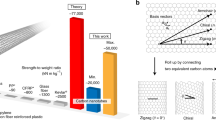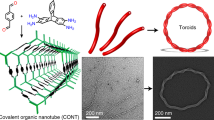Abstract
Carbon nanotubes1 display a consummate blend of materials properties that affect applications ranging from nanoelectronic circuits2 and biosensors3 to field emitters4 and membranes5. These applications use the non-covalent interactions between the nanotubes and chemical functionalities6, often involving a few molecules at a time. Despite their wide use, we still lack a fundamental understanding and molecular-level control of these interactions. We have used chemical force microscopy7 to measure the strength of the interactions of single chemical functional groups with the sidewalls of vapour-grown individual single-walled carbon nanotubes. Surprisingly, the interaction strength does not follow conventional trends of increasing polarity or hydrophobicity, and instead reflects the complex electronic interactions between the nanotube and the functional group. Ab initio calculations confirm the observed trends and predict binding force distributions for a single molecular contact that match the experimental results. Our analysis also reveals the important role of molecular linkage dynamics in determining interaction strength at the single functional group level.
This is a preview of subscription content, access via your institution
Access options
Subscribe to this journal
Receive 12 print issues and online access
$259.00 per year
only $21.58 per issue
Buy this article
- Purchase on Springer Link
- Instant access to full article PDF
Prices may be subject to local taxes which are calculated during checkout



Similar content being viewed by others
References
Hu, J. T., Odom, T. W. & Lieber, C. M. Chemistry and physics in one dimension: Synthesis and properties of nanowires and nanotubes. Acc. Chem. Res. 32, 435–445 (1999).
Dai, H. J. Carbon nanotubes: Synthesis, integration, and properties. Acc. Chem. Res. 35, 1035–1044 (2002).
Chen, R. J. et al. Noncovalent functionalization of carbon nanotubes for highly specific electronic biosensors. Proc. Natl Acad. Sci. USA 100, 4984–4989 (2003).
Fan, S. S. et al. Self-oriented regular arrays of carbon nanotubes and their field emission properties. Science 283, 512–514 (1999).
Holt, J. K. et al. Fast mass transport through sub-2-nanometer carbon nanotubes. Science 312, 1034–1037 (2006).
Terrones, M. Science and technology of the twenty-first century: Synthesis, properties and applications of carbon nanotubes. Annu. Rev. Mater. Res. 33, 419–501 (2003).
Noy, A., Vezenov, D. & Lieber, C. Chemical force microscopy. Annu. Rev. Mater. Sci. 27, 381–421 (1997).
Zheng, G., Patolsky, F., Cui, Y., Wang, W. U. & Lieber, C. M. Multiplexed electrical detection of cancer markers with nanowire sensor arrays. Nature Biotechnol. 23, 1294–1301 (2005).
Wang, J. F., Gudiksen, M. S., Duan, X. F., Cui, Y. & Lieber, C. M. Highly polarized photoluminescence and photodetection from single indium phosphide nanowires. Science 293, 1455–1457 (2001).
Liao, K. & Li, S. Interfacial characteristics of a carbon nanotube–polystyrene composite system. Appl. Phys. Lett. 79, 4225–4227 (2001).
Decossas, S. Interaction forces between carbon nanotubes and an AFM tip. Europhys. Lett. 53, 742–748 (2001).
Kharchenko, S. B., Douglas, J. F., Obrzut, J., Grulke, E. A. & Migler, K. B. Flow-induced properties of nanotube-filled polymer materials. Nature Mater. 3, 564–568 (2004).
Barber, A. H., Cohen, S. R. & Wagner, H. D. Measurement of carbon nanotube–polymer interfacial strength. Appl. Phys. Lett. 82, 4140–4142 (2003).
Poggi, M. A., Lillehei, P. T. & Bottomley, L. A. Chemical force microscopy on single-walled carbon nanotube paper. Chem. Mater. 17, 4289–4295 (2005).
Luan, B. & Robbins, M. O. The breakdown of continuum models for mechanical contacts. Nature 435, 929–932 (2005).
Grigg, D. A., Russell, P. E. & Griffith, J. E. Tip–sample forces in scanning probe microscopy in air and vacuum. J. Vac. Sci. Technol. A 10, 680–683 (1992).
Noy, A., Zepeda, S., Orme, C. A., Yeh, Y. & De Yoreo, J. J. Entropic barriers in nanoscale adhesion studied by variable temperature chemical force microscopy. J. Am. Chem. Soc. 125, 1356–1362 (2003).
Johnson, K. L. Contact Mechanics (Cambridge Univ. Press, Cambridge, 1987).
Ulman, A. Introduction to Ultrathin Organic Films (Academic Press, New York, 1991).
Strano, M. S. et al. Electronic structure control of single-walled carbon nanotube functionalization. Science 301, 1519–1522 (2003).
Usrey, M. L., Lippmann, E. S. & Strano, M. S. Evidence for a two-step mechanism in electronically selective single-walled carbon nanotube reactions. J. Am. Chem. Soc. 127, 16129–16135 (2005).
Someya, T., Small, J., Kim, P., Nuckolls, C. & Yardley, J. T. Alcohol vapor sensors based on single-walled carbon nanotube field effect transistors. Nano Lett. 3, 877–881 (2003).
Klinke, C., Chen, J., Afzali, A. & Avouris, P. Charge transfer induced polarity switching in carbon nanotube transistors. Nano Lett. 5, 555–558 (2005).
Star, A., Han, T. R., Gabriel, J. C. P. & Bradley, K. Interaction of aromatic compounds with carbon nanotubes: Correlation to the Hammett parameter of the substituent and measured carbon nanotube FET response. Nano Lett. 3, 1421–1423 (2003).
Wise, K. E., Park, C., Siochi, E. J. & Harrison, J. S. Stable dispersion of single wall carbon nanotubes in polyimide: The role of noncovalent interactions. Chem. Phys. Lett. 391, 207–211 (2004).
Evans, E. & Ritchie, K. Dynamic strength of molecular adhesion bonds. Biophys. J. 72, 1541–1555 (1997).
Dudko, O. K., Filippov, A. E., Klafter, J. & Urbakh, M. Beyond the conventional description of dynamic force spectroscopy of adhesion bonds. Proc. Natl Acad. Sci. USA 100, 11378–11381 (2003).
Robinson, J. A., Snow, E. S., Badescu, S. C., Reinecke, T. L. & Perkins, F. K. Role of defects in single-walled carbon nanotube chemical sensors. Nano Lett. 6, 1747–1751 (2006).
Jeffery, S. et al. Direct measurement of molecular stiffness and damping in confined water layers. Phys. Rev. B 70, 054114 (2004).
Tsukruk, V. V. & Bliznyuk, V. N. Adhesive and friction forces between chemically modified silicon and silicon nitride surfaces. Langmuir 14, 446–455 (1998).
Srivastava, D., Menon, M. & Cho, K. J. Nanoplasticity of single-wall carbon nanotubes under uniaxial compression. Phys. Rev. Lett. 83, 2973–2976 (1999).
Car, R. & Parrinello, M. Unified approach for molecular dynamics and density-functional theory. Phys. Rev. Lett. 55, 2471–2474 (1985).
Hamann, D. R. Generalized norm-conserving pseudopotentials. Phys. Rev. B 40, 2980 (1989).
Acknowledgements
We thank L. Hope-Weeks, N. Zaitseva (Lawrence Livermore National Laboratory, LLNL) and S. Peleshanko (Iowa State University) for technical assistance and T. Sulchek (LLNL) for discussions. A.N. acknowledges LDRD SI funding, and G.G. acknowledges support from DOE grant DE-FG02-06ER46262, V.V.T. and M.C.L. acknowledge funding from AFOSR, FA9550-05-1-0209 and NSF-NIRT-0506832 grants, and A.B.A. and R.W.F. acknowledge LLNL SEGRF Program support. J.C.G. is grateful for partial support from NSF Grant No. EEC-0425914. This work was performed at the Lawrence Livermore National Laboratory under the auspices of the US Department of Energy under Contract No. W-7405-Eng-48.
Author information
Authors and Affiliations
Contributions
A.N., V.V.T., G.G. and J.C.G. conceived the experiments. R.W.F, M.C.L., A.B.A. and A.N. performed the experiments, and analysed the data. G.C., J.C.G. and G.G. performed computer simulations. A.N., R.W.F., G.C. and G.G. co-wrote the manuscript. All authors discussed the results and commented on the manuscript.
Corresponding authors
Supplementary information
Supplementary Information
Supplementary figures S1 and S2 (PDF 534 kb)
Rights and permissions
About this article
Cite this article
Friddle, R., Lemieux, M., Cicero, G. et al. Single functional group interactions with individual carbon nanotubes. Nature Nanotech 2, 692–697 (2007). https://doi.org/10.1038/nnano.2007.334
Received:
Accepted:
Published:
Issue Date:
DOI: https://doi.org/10.1038/nnano.2007.334
This article is cited by
-
Viscoelastic, ductile and repairable carbon nanotube films formed with CNT/PEI double networks containing branched polyethylenimine
NPG Asia Materials (2023)
-
A review on the role of interface in mechanical, thermal, and electrical properties of polymer composites
Advanced Composites and Hybrid Materials (2018)



